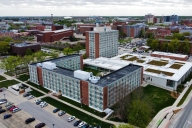You have /5 articles left.
Sign up for a free account or log in.
Homelessness is a serious problem in our society. A new book, Addressing Homelessness and Housing Insecurity in Higher Education (Teachers College Press), aims to portray the problem as a crucial one for higher education. The authors -- Ronald E. Hallett, professor of organizational leadership at the University of La Verne; Rashida M. Crutchfield, associate professor of social work at California State University, Long Beach; and Jennifer J. Maguire, associate professor of social work at Humboldt State University -- recently responded via email to questions about their book.
Their answers follow.
Q: There has been strong disagreement about the size of the problem with regard to housing. Where do you come down?
A: The federal government has yet to require postsecondary institutions to gather and report data related to food and housing insecurity. As a result, we do not have national-level statistics about the size and scope of homelessness and housing insecurity among college students. However, multiple research studies from across the nation over the past decade have resulted in fairly consistent results. About 10 to 15 percent of college students experience homelessness with an additional 20 to 30 percent having experienced housing insecurity while attending college. Community colleges tend to have higher rates and elite institutions have lower rates, but all institutions have students who fall into both categories.
We recommend that postsecondary institutions do internal analysis of their student body to understand the issue within the local context. There are good measures that can be integrated within institutional data collection to help institutions understand the size and scope of the issue in order to make decisions about how to address the issue. We also encourage institutions to share these reports. As institutions do this, policy makers can get a better understanding of how homelessness and housing insecurity are issues that impact all institutional types across the nation, and this may motivate more action at the federal level. In addition, we encourage adding questions about food and housing insecurity to national surveys in order to get consistent data about the size and scope of the issue among college students.
Q: There are some who say that the problem has gotten much worse, and others who say that the situation has always been bad but just has not received attention. What you think?
A: The issue of basic needs insecurity among college students is not a new phenomenon. We have been studying this issue for about 15 years and have personal experiences that span much longer than that. We feel confident saying that the issue of food and housing insecurity has existed for several decades. Since consistent data collection did not exist previously, it is difficult to know with certainty if the issue has increased in intensity and, if so, by how much. However, policy makers, researchers and practitioners have become more aware of the issue over the past decade. We hope that postsecondary institutions experience urgency in addressing the issue as more data emerge to confirm what many practitioners have known for years.
Q: Looking at food insecurity, how can colleges make sure that students have basic levels of food security, especially colleges that serve many students who are the edge of financial insecurity?
A: Our book does not specifically address food security, however, food and housing insecurity often overlap. We feel strongly that commitment to student success in higher education must include addressing basic needs, which include housing and food, along with mental and physical health. For example, postsecondary institutions can provide opportunities for students to get support filling out Supplemental Nutritional Assistance Program (SNAP) applications (SNAP has colloquially been called “food stamps”) as well as creating food pantries on campus.
Q: What about students at elite and private institutions? Are there particular issues that are common?
A: Food and housing insecurity are significant issues that college students experience while attending all institutional types. Emerging research illustrates how elite public and private universities are finding that they have students experiencing food and housing insecurity. These institutions may have slightly lower rates of basic needs insecurity than public institutions, however, additional data are needed to fully understand the experiences of students at these institutions.
A few insights have emerged from current research at elite and private institutions. First, the high cost of tuition may result in low-income students utilizing all of their financial aid to cover tuition, books and fees. They may have little money left for housing. This can be particularly important for institutions that underestimate the cost of housing. Second, graduate students may have higher rates of food and housing insecurity since there are fewer need-based federal grants and other forms of support. Third, students may experience a personal or familial crisis once they begin classes. Even though they may have had financial resources at the start of their first year, they may be in a significantly different situation after the crisis. Finally, staff and instructors at elite institutions may have fewer connections with community agencies than their public school counterparts.
Q: Can the problems in your book be solved, given the high rates among nonstudents?
A: Homelessness and housing insecurity are important issues in the United States. The issues framing basic needs insecurity are complex. Completely resolving the issue will be difficult without restructuring our social and economic systems. However, higher education can play a significant role in reducing the likelihood that individuals will experience housing insecurity. The Great Recession demonstrated how completing a two-year or four-year certificate or degree significantly reduced the likelihood that individuals would experience loss of job or housing. For individuals experiencing homelessness and housing insecurity, completing a postsecondary degree can be a pathway out of poverty. While improving postsecondary access and retention may not completely resolve the issue, it is an important aspect of the solution.








